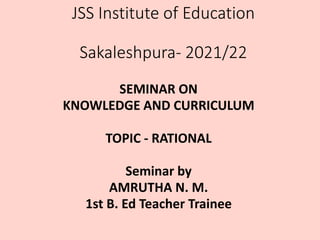
KAC seminar by Amrutha.pptx
- 1. JSS Institute of Education Sakaleshpura- 2021/22 SEMINAR ON KNOWLEDGE AND CURRICULUM TOPIC - RATIONAL Seminar by AMRUTHA N. M. 1st B. Ed Teacher Trainee
- 2. Contents 1. Introduction 2. Etymological meaning of Rational 3. Definitions 4. Rational Knowledge 5. Bases of Rational knowledge 6. Characteristics of Rational 7. Conclusion 8. Reference
- 3. Introduction Living rationally is living consciously. It is using the cognitive powers you have been endowed to make decisions about your life and beliefs.Rationality should strive to understand where the emotions originate so it can consciously solve problems and redirect them.
- 4. Etymological meaning of Rational The word Rational derived from the Latin word "Rationalis"which means "reasonable" Rational : real, existing state, experiencing fact
- 5. Definitions According to Cambridge Dictionary - Rational means showing clear thought or reason. According to Maxmilan Dictionary - Rational means sensible and reasonable Rational is really existing and experiencing fact. It nothing but whatever an individual really feels or experiences by his senses.
- 6. Rational knowledge Rational knowledge can be defined as a thinking process which is based on reason and logic. A person who thinks rationally would pay attention to the factual basis. He would analyse the possible outcomes of the situation and his response before acting. Even in the face of a difficult situation, a person who thinks rationally can look beyond the emotions that he feels at that particular moment and act wisely. He would not become a slave of his emotions. When engaging in rational thinking the individual uses all the information available to him. This can be his past experiences, what he had heard, whatever information available. This allows him to choose the best option.
- 7. Example In a work environment an employee was accused by his supervisor, for something he did not do. A rational person would look past the emotions and consider the facts available to him such as Why did he acuse? What led him to think that? Has some mistake occurred in his work?, etc. It is only after this that he would decide what to do.
- 8. Rational Knowledge has three bases 1. Rationalism as the intuitive and deductive knowledge
- 10. 2. Rationalism as the innate knowledge The innate knowledge asserts the existence of knowledge gained a priori, independence of experience. Our innate knowledge is not learned through either sense experience or intuition and deduction. It is just part of our nature. An example of this is when a horse is born and can immediately walk. The horse has not learned this behavior; it simply knows how to do it. In some scenarios, innate knowledge is more beneficial than learned knowledge.
- 11. 3. Rationalism as the innate concept According to the innate concept, some of our concepts are not gained from experience. They are part of our rational nature in such a way that, while sense experiences trigger a process by which they are brought to consciousness, experience doesn't provide the concepts or determine the information they contain.
- 12. Characteristics of Rational 1. Rational has agreeable reasons. 2. Rational is a thinking process based on reason and logic. 3. Rational is driven by experience and facts. 4. Rational is based on evidences. 5. Rational is sensible project. 6. Rational has real, true and valued reason. 7. Rational includes human rational theories.
- 13. Conclusion Rational signifies that what do we know something, or what we claim to know as true. Rational thinking helps a person to take correct decision because it is real and experiencing fact. Also it is based on reason and logic.
- 14. Reference • Knowledge and Curriculum By Ramachandraiah Published by Vismaya Prakashana • Knowledge and Curriculum By Shivakumar S. K.
- 15. Thank you